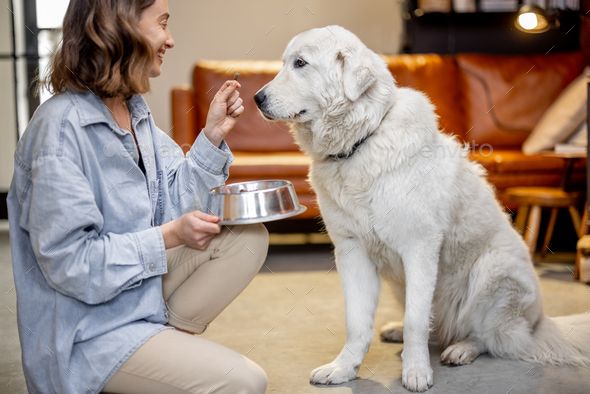Dog / Detail
A Tale of Two Tails: A Dog's Preference for Dad
Jonathan Bennet | 16 September 2024 | 16:05
Dogs, often referred to as "man's best friend," are known for their loyalty, affection, and sometimes, their quirky behaviors. While many dogs form strong bonds with their primary caregivers, be it a mother, father, or both, there are instances where a dog exhibits a peculiar preference for one parent over the other.
This article explores a common scenario: a dog who is close to its mother due to feeding but prefers the company of its father or another male figure in the household.
A dog's preference for a male caregiver, despite being close to its mother for feeding, is a fascinating aspect of canine behavior.
It highlights the complexity of dog-human relationships and the various factors that can influence a dog's emotional attachments. By understanding these factors, we can better appreciate the unique personalities and behaviors of our canine companions.

Understanding Canine Behavior
Before delving into the specific case of a dog's preference for a male caregiver, it's essential to understand some basic canine behaviors. Dogs are social creatures that thrive on companionship. They form strong bonds with their human families and often exhibit behaviors that reflect their deep-seated need for connection.
- Imprinting: Dogs, like many other animals, can imprint on their primary caregiver during their early development. This means they form a strong emotional attachment to the individual who is most influential in their lives during this critical period.
- Dominance Hierarchy: Dogs often establish a dominance hierarchy within their social group, including human families. This hierarchy can influence their interactions and behaviors, including their level of affection and submission.
- Playful Behavior: Dogs are naturally playful creatures. Playful interactions can strengthen bonds between dogs and their human companions and can also contribute to the development of preferences.

The Role of Feeding
Feeding is a fundamental aspect of a dog's relationship with its human family. It provides nourishment and reinforces the bond between the dog and its caregivers. In many cases, the primary caregiver who is responsible for feeding the dog becomes the dog's primary source of comfort and security.
However, it's important to note that feeding alone does not determine a dog's primary attachment. While a dog may be grateful for food, other factors, such as play, companionship, and emotional support, also play a significant role in shaping its bonds.
The Influence of Male Figures
Despite being close to its mother due to feeding, a dog may exhibit a strong preference for its father or another male figure in the household. This preference can be influenced by several factors:
- Playful Interactions: Male figures often engage in more physically demanding play with dogs, which can be appealing to dogs who enjoy active activities.
- Dominance Dynamics: In some cases, a male figure may naturally assume a more dominant role within the family, which can be attractive to dogs who seek leadership and guidance.
- Emotional Connection: Dogs can form deep emotional connections with any human who provides them with love, affection, and attention. A male figure who consistently shows these qualities can become a dog's preferred companion.

Individual Differences
It's important to remember that every dog is unique, and their behaviors can vary greatly. While the factors discussed above may influence a dog's preference for a male caregiver, individual differences in personality, upbringing, and experiences can also play a significant role.
Canine Attachment Styles
- Secure vs. Insecure Attachment: Research on canine attachment styles can provide insights into how dogs form bonds with their humans. Securely attached dogs tend to be more confident and trusting, while insecurely attached dogs may exhibit anxiety or avoidance.
- The Role of Early Socialization: Early socialization experiences can significantly impact a dog's attachment style. Studies on early socialization practices can shed light on how these experiences shape a dog's relationships with people.
Hormonal Influences
- Oxytocin: Oxytocin, often referred to as the "love hormone," plays a crucial role in social bonding. Research on oxytocin levels in dogs can help explain why certain dogs form stronger bonds with specific individuals.
- Testosterone: Testosterone levels in male dogs might influence their interactions with other dogs and humans. Studies on the relationship between testosterone and canine behavior could provide valuable information.

Play Behavior and Bonding
- Rough-and-Tumble Play: Research on rough-and-tumble play between dogs and humans can explore how this type of play contributes to bonding and the development of preferences.
- The Role of Play in Stress Reduction: Studies on the stress-reducing effects of play can help explain why dogs might prefer caregivers who engage in playful activities with them.
Genetics and Breed Differences
- Heritability of Behavior: Research on the heritability of canine behavior can identify genetic factors that influence a dog's personality and social interactions.
- Breed-Specific Traits: Certain dog breeds may have innate tendencies that predispose them to form stronger bonds with specific individuals. Studies on breed-specific behaviors can provide insights into these differences.

Human-Dog Interactions
- Non-Verbal Communication: Research on human-dog communication can explore how subtle cues and body language influence a dog's behavior and preferences.
- The Impact of Human Personality: Studies on the relationship between human personality traits and dog behavior can help understand how a caregiver's personality might influence a dog's attachment.
- By incorporating findings from these research areas, you can provide a more comprehensive and evidence-based understanding of a dog's preference for a male caregiver.
Related
-

The Healing Power of Dogs: How Canine Therapy is Revolutionizing Mental Health and Boosting Positive Energy in Humans
Dog14 November 2024
-

A Pawsitive History: Dogs of Nuremberg
Dog09 November 2024
-

The Role of Oxytocin in the Human-Dog Bond: The Science Behind Our Deep Connection
Dog06 November 2024
-

Beyond the Beach: Jamaica's Dog Lovers
Dog29 October 2024
-

A Dog's Delights: Homemade Snacks for Our Furry Babies, Recipes Included!
Dog29 October 2024
-

A Dog's Disorientation: Understanding Your Dogs' Wanderlust
Dog29 October 2024
Popular
-

-

A Pawsitive History: Dogs of Nuremberg
09 November 2024 -

-

Beyond the Beach: Jamaica's Dog Lovers
29 October 2024 -
